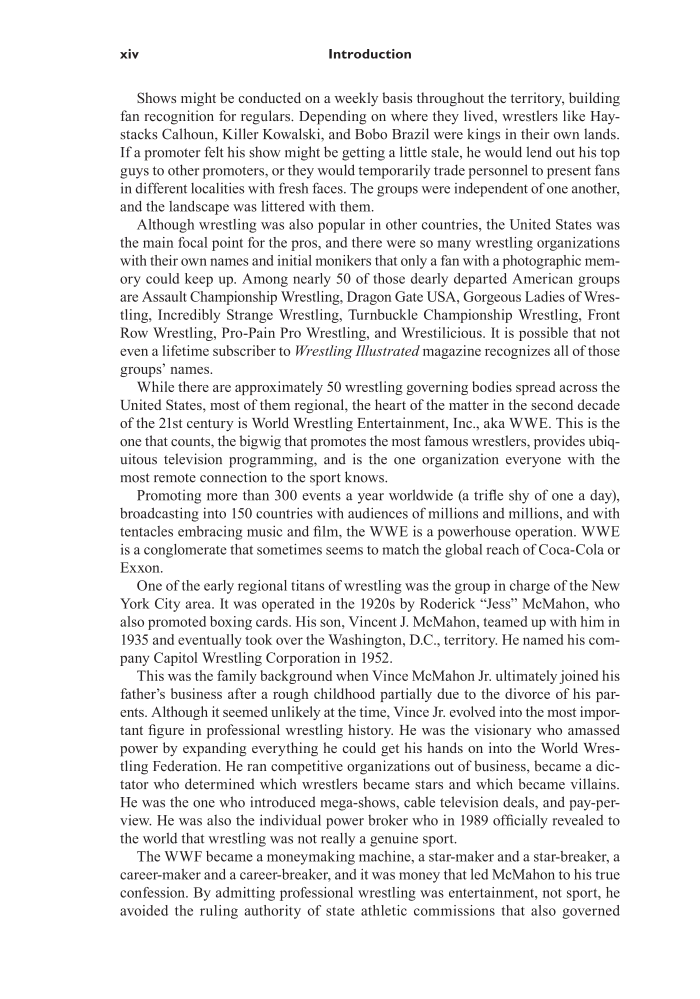xiv Introduction Shows might be conducted on a weekly basis throughout the territory, building fan recognition for regulars. Depending on where they lived, wrestlers like Hay- stacks Calhoun, Killer Kowalski, and Bobo Brazil were kings in their own lands. If a promoter felt his show might be getting a little stale, he would lend out his top guys to other promoters, or they would temporarily trade personnel to present fans in different localities with fresh faces. The groups were independent of one another, and the landscape was littered with them. Although wrestling was also popular in other countries, the United States was the main focal point for the pros, and there were so many wrestling organizations with their own names and initial monikers that only a fan with a photographic mem- ory could keep up. Among nearly 50 of those dearly departed American groups are Assault Championship Wrestling, Dragon Gate USA, Gorgeous Ladies of Wres- tling, Incredibly Strange Wrestling, Turnbuckle Championship Wrestling, Front Row Wrestling, Pro-Pain Pro Wrestling, and Wrestilicious. It is possible that not even a lifetime subscriber to Wrestling Illustrated magazine recognizes all of those groups’ names. While there are approximately 50 wrestling governing bodies spread across the United States, most of them regional, the heart of the matter in the second decade of the 21st century is World Wrestling Entertainment, Inc., aka WWE. This is the one that counts, the bigwig that promotes the most famous wrestlers, provides ubiq- uitous television programming, and is the one organization everyone with the most remote connection to the sport knows. Promoting more than 300 events a year worldwide (a trifle shy of one a day), broadcasting into 150 countries with audiences of millions and millions, and with tentacles embracing music and film, the WWE is a power house operation. WWE is a conglomerate that sometimes seems to match the global reach of Coca-Cola or Exxon. One of the early regional titans of wrestling was the group in charge of the New York City area. It was operated in the 1920s by Roderick “Jess” McMahon, who also promoted boxing cards. His son, Vincent J. McMahon, teamed up with him in 1935 and eventually took over the Washington, D.C., territory. He named his com pany Capitol Wrestling Corporation in 1952. This was the family background when Vince McMahon Jr. ultimately joined his father’s business after a rough childhood partially due to the divorce of his par- ents. Although it seemed unlikely at the time, Vince Jr. evolved into the most impor tant figure in professional wrestling history. He was the visionary who amassed power by expanding everything he could get his hands on into the World Wres- tling Federation. He ran competitive organizations out of business, became a dic- tator who determined which wrestlers became stars and which became villains. He was the one who introduced mega-shows, cable television deals, and pay-per- view. He was also the individual power broker who in 1989 officially revealed to the world that wrestling was not really a genuine sport. The WWF became a moneymaking machine, a star- maker and a star- breaker, a career- maker and a career- breaker, and it was money that led McMahon to his true confession. By admitting professional wrestling was entertainment, not sport, he avoided the ruling authority of state athletic commissions that also governed
Document Details My Account Print multiple pages
Print
You have printed 0 times in the last 24 hours.
Your print count will reset on at .
You may print 0 more time(s) before then.
You may print a maximum of 0 pages at a time.









































































































































































































































































































































